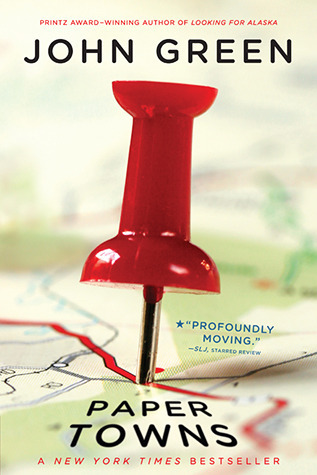1:09 PM
 Paper Towns by John Green | Rating: ★★★★☆
Paper Towns by John Green | Rating: ★★★★☆
“Here’s what’s not beautiful about it: from here, you can’t see the rust or the cracked paint or whatever, but you can tell what the place really is. You can see how fake it all is. It’s not even hard enough to be made out of plastic. It’s a paper town. I mean, look at it, Q: look at all those culs-de-sac, those streets that turn in on themselves, all the houses that were built to fall apart. All those paper people living in their paper houses, burning the future to stay warm. All the paper kids drinking beer some bum bought for them at the paper convenience store. Everyone demented with the mania of owning things. All the things paper-thin and paper-frail. And all the people, too. I’ve lived here for eighteen years and I have never once in my life come across anyone who cares about anything that matters.”
Ugh, I know, right? A John Green book. So, like, totally, like cliche. But here’s the thing: I love John Green and his work. Say what you will, but I’m not going to deny that I love the way his words flow and his stories. His novels may often have a repetitive theme to it in terms of how his characters act but they still, for me, provide my mind with the opportunity to think. Really and truly think, you know? And that’s important when reading a novel.
And I’d like to make it clear that in spite of flaws and the certain level of pretentious that his characters sometimes reach, I think that his books are something special.
Onto the review: Paper Towns maintains a balance between drama and comedy very well. There are strong elements of friendship and the intrigue of a young, unrequited love. Mystery is also a common thing found in the novel upon the search for a friend who up and left behind a life in order to search for another one.
Our narrator, Q, can be irritatingly self centered and has all these ideals about the world that may get under your skin, but for the most part he is pretty easy to relate to. He is very endearing from times and while he has his flaws, I did come to appreciate his character very much so throughout the story. It was especially nice to see him grow and slowly but surely start to understand that the world out there isn’t just something he sees in passing — there are many things yet to be learned.
Each character we meet has that same level of quirky and unique moments that John Green is known for, and while many think it’s repetitive and unrealistic that teens talk or think in certain ways — it is realistic. Over the course of the novel we come in contact briefly with Q’s friends who will later play a major part throughout the story.
All of these players to our tale grow and provide light, comedic moments as they attempt to balance their final days in high school as well as their friendships and unfolding the mystery that is Margo. What I liked most in the story was the moments between the main character and his friends, as well as the addition of Lacey — who later dates one of Q’s friends and was once Margo’s best friend. They each represent what a real friendship looks like and share many great, entertaining moments with one another by the end of our story.
Most importantly, we meet Margo at the very start. We see a glimpse of her and Q when they were children, and have the unfortunate luck in finding a dead man, and even then we begin to see Margo as something of a mystery. Years go by as our story flashes to present day, the two’s senior year of high school, and they don’t really talk anymore. But one night, Margo — irritated with life; seeking out revenge on her former best friend and ex boyfriend — shows up in Q’s house and together they have one all-nighter filled with unforgettable moments that will likely stick with Q and Margo for the rest of their lives.
And then, she leaves.
By the end of the novel, you see the mystery unfold. Where is Margo? Who is she, really? Everyone, even those close to her, know so little about her. But through the time that four of our characters search for her they grow out of their high school selves; they begin to understand one another and themselves. And maybe, just maybe — once they find Margo — they’ll even start to understand her.
Maybe.
Personally, I thought this story was lovely and one of his best. And I would recommend it to many, but I also acknowledge that it won’t be everybody’s cup of tea. So check it out for yourself, yeah?
My only solid complaint was the use of the word ‘retarded’ (it does make it realistic, however, since teens often do misuse this word) and the way Q’s friend Ben viewed females. But again, this is rather realistic in terms of how teenagers act and think.

















0 comments